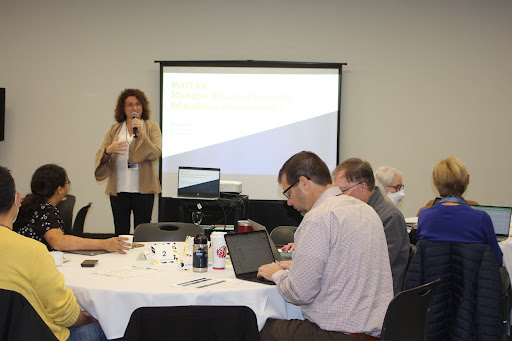Microelectronics researchers plan new initiative, enhanced collaboration to aid semiconductor industry

Leading microelectronics researchers at the University of Michigan gathered recently to assess opportunities to accelerate the nation’s efforts to revitalize the domestic semiconductor industry. As the United States aims to re-shore semiconductor manufacturing, attendees discussed how to leverage Michigan’s existing strengths to support the effort through the establishment of Michigan’s Advanced Vision for Education and Research in Integrated Circuits, or MAVERIC.
“The pandemic brought major supply chain issues to the integrated circuit space, underscoring the vital role that semiconductors now play in our lives and economy. It’s clear that we need to bring chip manufacturing back to the US and boost innovation in the field,” says Valeria Bertacco, the Mary Lou Dorf Collegiate Professor of Computer Science and Engineering.”The University of Michigan is positioned to serve as a national hub for innovations addressing the needs of the nanotechnology industry. We look forward to partnering with industry collaborators in advancing our research and educational mission within the broad semiconductor domain.”
U-M is a top-three research institution in hardware systems, number one in computer architecture and VLSI design by number of publications in selective conferences, and is among the top universities overall for nanotechnology research, including novel materials and devices. It houses the Lurie Nanofabrication Facility, in use by more than 400 students and researchers at U-M every year, as well as other academic institutions, national labs and more than 100 industry partners in the past five years. Its College of Engineering is among the largest engineering schools in the country, developing top-notch talent in microelectronics, a significant advantage as semiconductor industry leaders seek to fill over 50,000 engineering positions over the next 10 years.
“We’re at the crossroads for semiconductors here in the US,” said Eric Michielssen, Associate Dean for Research at Michigan Engineering and Louise Ganiard Johnson Professor of Engineering. “Research universities like U-M have a very important role to play in this transition. Today is all about brainstorming new ideas that will produce both the talent as well as the know-how for the industry in this country to succeed.”
The CHIPS and Science Act, signed into law by President Joe Biden on August 9, 2022, marked a landmark commitment by the US government to build robustness into the microelectronics supply chain and re-establish the country’s leadership in microelectronics innovation, Bertacco says.
Michigan researchers participating in the retreat discussed U-M’s readiness to address the full spectrum of the microelectronics industry’s needs and key innovations that they are uniquely positioned to offer. In particular, the discussion revolved around research on new materials and device paradigms, resilient hardware systems and building high-trust systems from low-trust silicon sources. The group also discussed the contributions that U-M can offer in building collaborative industry-academia partnerships and in designing modern education for US leadership in nanotechnology by 2040.
“Today is an opportunity to bring together our faculty and colleagues to think about how to address semiconductor challenges in the US as the collective University of Michigan,” Bertacco said. “At the University of Michigan, we have the expertise, the large student population and the drive to solve this grand challenge together.”
 MENU
MENU 
